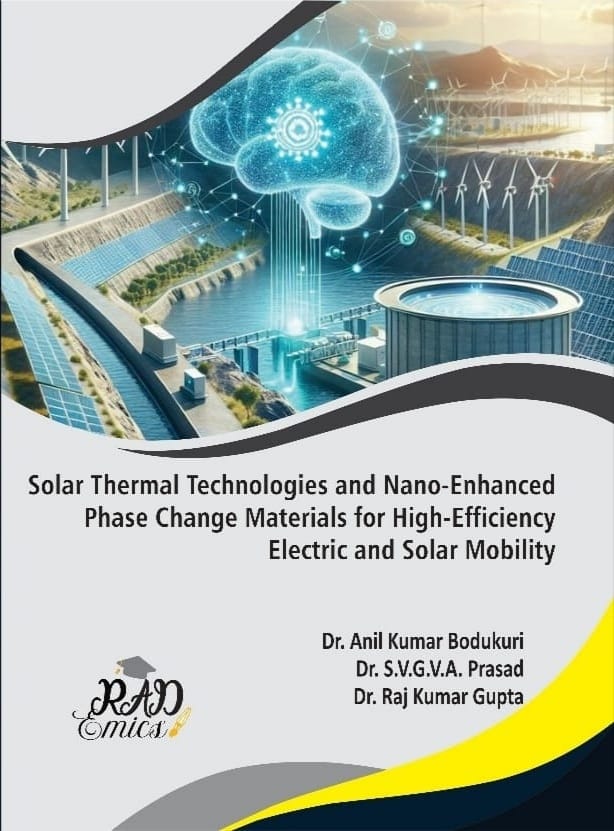
Abstract
The rising demand for high-performance electric vehicles (EVs) has intensified the need for efficient thermal management solutions to optimize the charging and discharging cycles of lithium-ion batteries. Nano-enhanced phase change materials (NEPCMs) have emerged as a transformative innovation in battery thermal regulation, offering superior heat absorption, storage, and dissipation properties that significantly mitigate thermal stress and improve battery longevity. This book chapter presents a comprehensive exploration of the impact of NEPCMs on battery performance, with a particular emphasis on their role in enhancing energy efficiency, safety, and system reliability during rapid charge–discharge cycles. Beyond material innovation, the chapter introduces a novel interdisciplinary framework that integrates algorithmic intelligence with social pedagogy to bridge the gap between technological advancement and societal engagement. Artificial intelligence (AI) is leveraged for predictive analytics, real-time monitoring, and adaptive energy management, while social pedagogical strategies ensure inclusive stakeholder education, participatory learning, and community-driven adoption. The synthesis of these approaches creates a user-centric and ethically responsible roadmap for implementing NEPCMs in EVs, emphasizing the critical importance of educational equity, informed policy-making, and cross-sector collaboration. By aligning cutting-edge nanotechnology with AI-based analytics and socially embedded learning environments, this chapter underscores the imperative for holistic, sustainable, and human-centered energy transitions in the electric mobility sector.
Introduction
The global automotive landscape is undergoing a transformative shift towards electrification, driven by escalating concerns over climate change, energy security, and environmental degradation. Electric vehicles, powered predominantly by lithium-ion batteries, are increasingly viewed as a viable and sustainable alternative to internal combustion engine vehicles [1]. Theoperational efficiency, safety, and longevity of these batteries are significantly influenced by thermal conditions, especially during intense charge and discharge cycles [2]. These thermal stresses, if unmanaged, can result in rapid capacity fade, reduced cycle life, and safety hazards such as thermal runaway. Consequently, thermal management has emerged as a critical area of focus in battery research. Conventional passive and active cooling methods often fall short in delivering consistent temperature regulation across all operating conditions [3]. In this context, phase change materials, particularly those enhanced with nanomaterials, have shown immense promise [4]. These nano-enhanced PCMs offer superior thermal conductivity and latent heat storage capabilities, effectively mitigating temperature fluctuations and improving overall battery stability. As the demand for high-performance electric vehicles continues to grow, integrating these materials within battery systems offers a strategic solution to address the evolving challenges of battery heating, energy retention, and safety [5].
Nano-enhanced phase change materials represent a significant leap in thermal interface technology for lithium-ion batteries [6]. Unlike traditional PCMs, which often suffer from low thermal conductivity and slow heat transfer rates, NEPCMs leverage the unique properties of embedded nanostructures—such as carbon nanotubes, metal oxides, or graphene—to enhance heat distribution and accelerate thermal response [7]. These advanced materials undergo phase transitions that absorb or release large quantities of thermal energy without changing temperature, thereby maintaining the battery’s temperature within an optimal range during both charging and discharging phases. NEPCMs are particularly suited for compact, high-power battery packs in electric vehicles where space and weight constraints limit the use of bulky or energy-intensive cooling systems [8]. , their passive nature ensures energy efficiency, reducing the load on auxiliary thermal management subsystems.  Theintegration of NEPCMs is not without challenges. Material compatibility, encapsulation techniques, long-term stability, and scalability are critical considerations that influence their practical deployment. Addressing these challenges demands a comprehensive understanding of both material science and system-level battery design [9]. As the industry accelerates toward mass adoption, the role of NEPCMs in ensuring thermal safety, operational efficiency, and energy resilience becomes increasingly vital to future innovations [10].